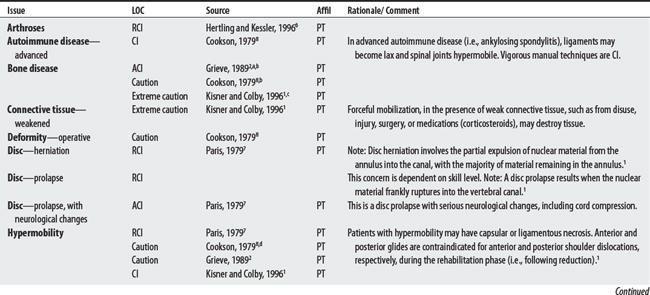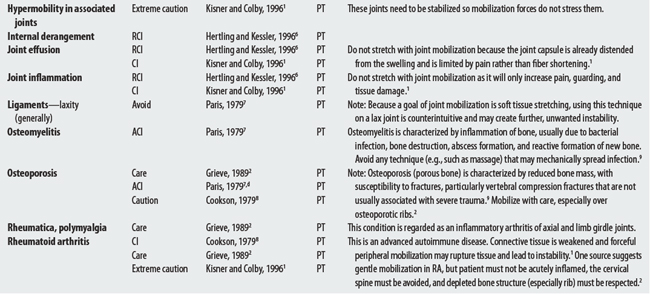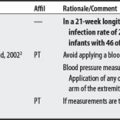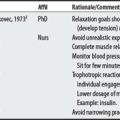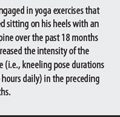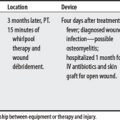Chapter 25 Joint Mobilization (Articulation, Nonthrust Technique; Nonimpulse Technique)
OVERVIEW.
Joint mobilization (also called articulation, non-thrust) is a manual technique directed to the patient’s joint whereby the clinician imparts passive movements such as glides and distractions. The technique is characterized by low-velocity movements (i.e., rather than high-velocity thrusts) and is generally slow enough for the patient to stop. The goal is to relieve pain or improve range of motion by improving joint play and restoring the roll and glide arthrokinematics of the joint.1
SUMMARY: CONTRAINDICATIONS AND PRECAUTIONS.
Seven sources cited a total of 51 concerns for joint mobilization. Concerns ranged from four to 18 per source. All seven sources were physical therapists. The largest proportion of concerns were musculoskeletal (>40%). The most frequently cited concern was neoplasm followed by recent fracture and hypermobility. Several absolute CIs were also listed. Notes: Grieve,2 Kisner and Colby,1 and Sprague3 address spinal mobilization, peripheral joint mobilization, and the cervical spine concerns, respectively. Harris and Lundgren4 address pediatric concerns with nervous system disorders.
CONTRAINDICATIONS AND PRECAUTIONS
A00-B99 CERTAIN INFECTIONS AND PARASITIC DISEASES
F00-F00 MENTAL AND BEHAVIORAL DISORDERS
G00-G99 DISEASES OF THE NERVOUS SYSTEM
I00-I99 DISEASES OF THE CIRCULATORY SYSTEM
J00-J99 DISEASES OF THE RESPIRATORY SYSTEM
M00-M99 DISEASES OF THE MUSCULOSKELETAL SYSTEM AND CONNECTIVE TISSUE
O00-O99 PREGNANCY, CHILDBIRTH, AND PUERPERIUM
Q00-Q99 CONGENITAL MALFORMATIONS, DEFORMITIES AND CHROMOSOMAL ABNORMALITIES
R00-R99 SYMPTOMS, SIGNS, AND ABNORMAL CLINICAL AND LABORATORY FINDINGS (NOT ELSEWHERE CLASSIFIED)
S00-T98 INJURY, POISONING, AND CERTAIN OTHER CONSEQUENCES OF EXTERNAL CAUSES
1 Kisner C, Colby LA. Therapeutic exercise: foundations and techniques, ed 3. Philadelphia: F.A. Davis, 1996.
2 Grieve GP. Contra-indications to spinal manipulation and allied treatments. Physiotherapy. 1989;75(8):445-453.
3 Sprague RB. The acute cervical joint lock. Phys Ther. 1983;63(9):1439-1444.
4 Harris SR, Lundgren BD. Joint mobilization for children with central nervous system disorders: indications and precautions. Phys Ther. 1991;71(12):890-896.
5 Michaeli A. Reported occurrence and nature of complications following manipulative physiotherapy in South Africa. Aust Physiother. 1993;39(4):309-315.
6 Hertling D, Kessler RM. Introduction to manual therapy. In Hertling D, Kessler RM, editors: Management of common musculoskeletal disorders: Physical therapy principles and methods, ed 3, Philadelphia: Lippincott-Raven, 1996.
7 Paris SV. Mobilization of the spine. Phys Ther. 1979;59(8):988. 985
8 Cookson JC. Orthopedic manual therapy: An overview. Phys Ther. 1979;59(3):259-267.
9 Brashear HRJr, Raney RBSr. Shand’s handbook of orthopaedic surgery, ed 9. St. Louis: CV Mosby, 1978.









